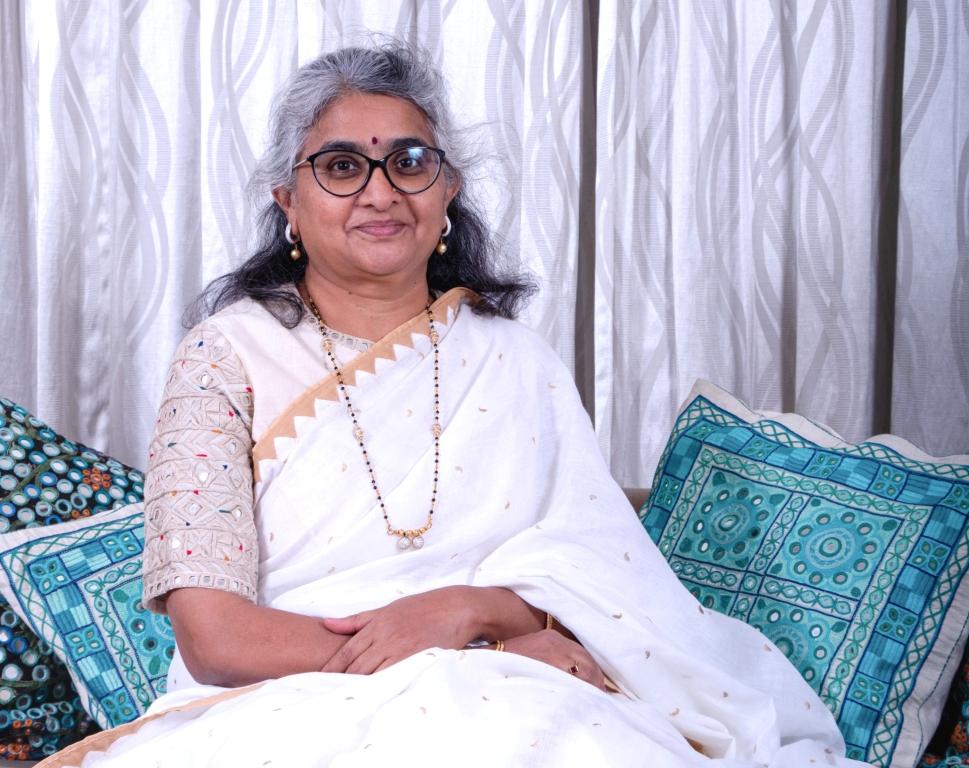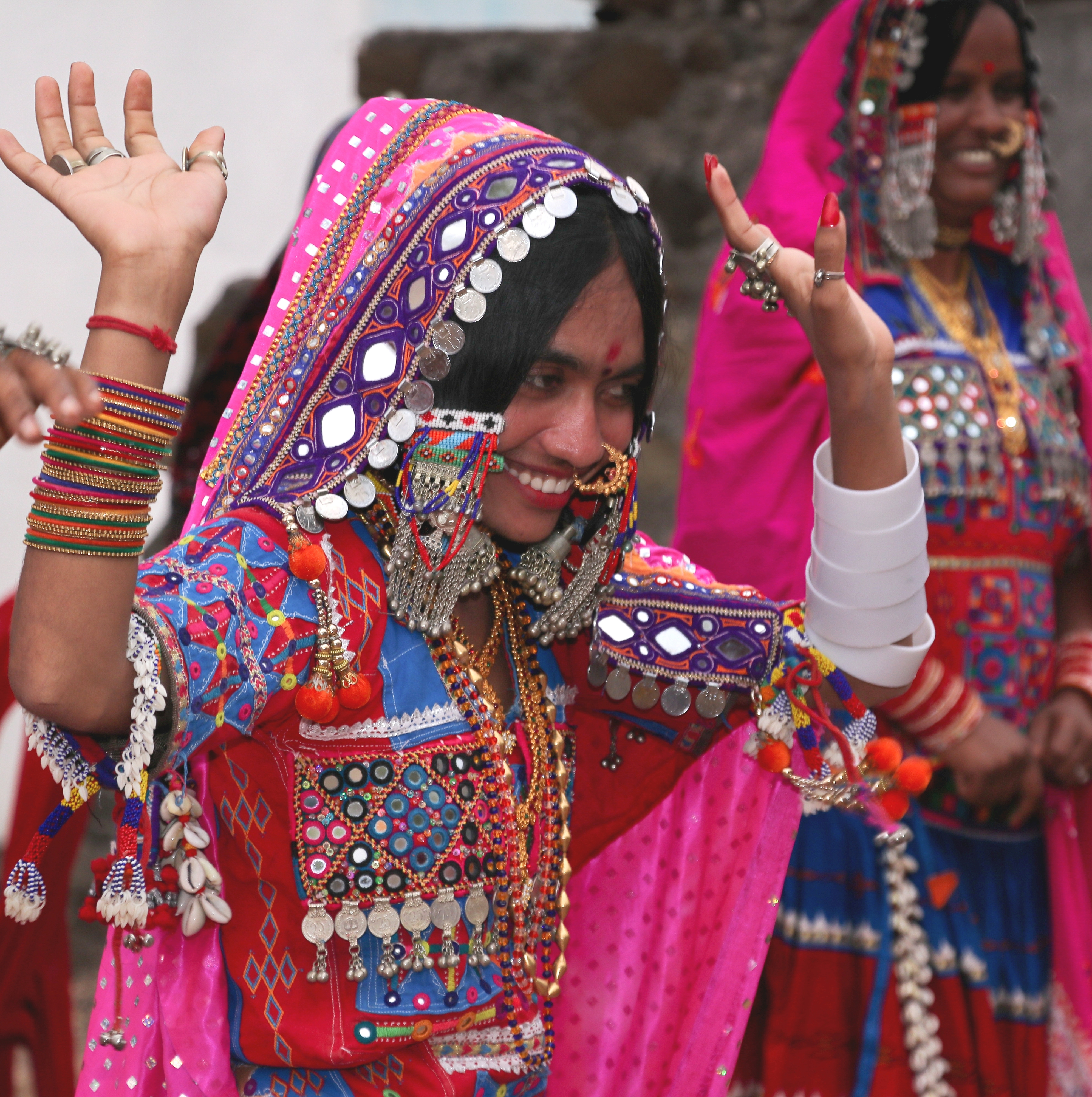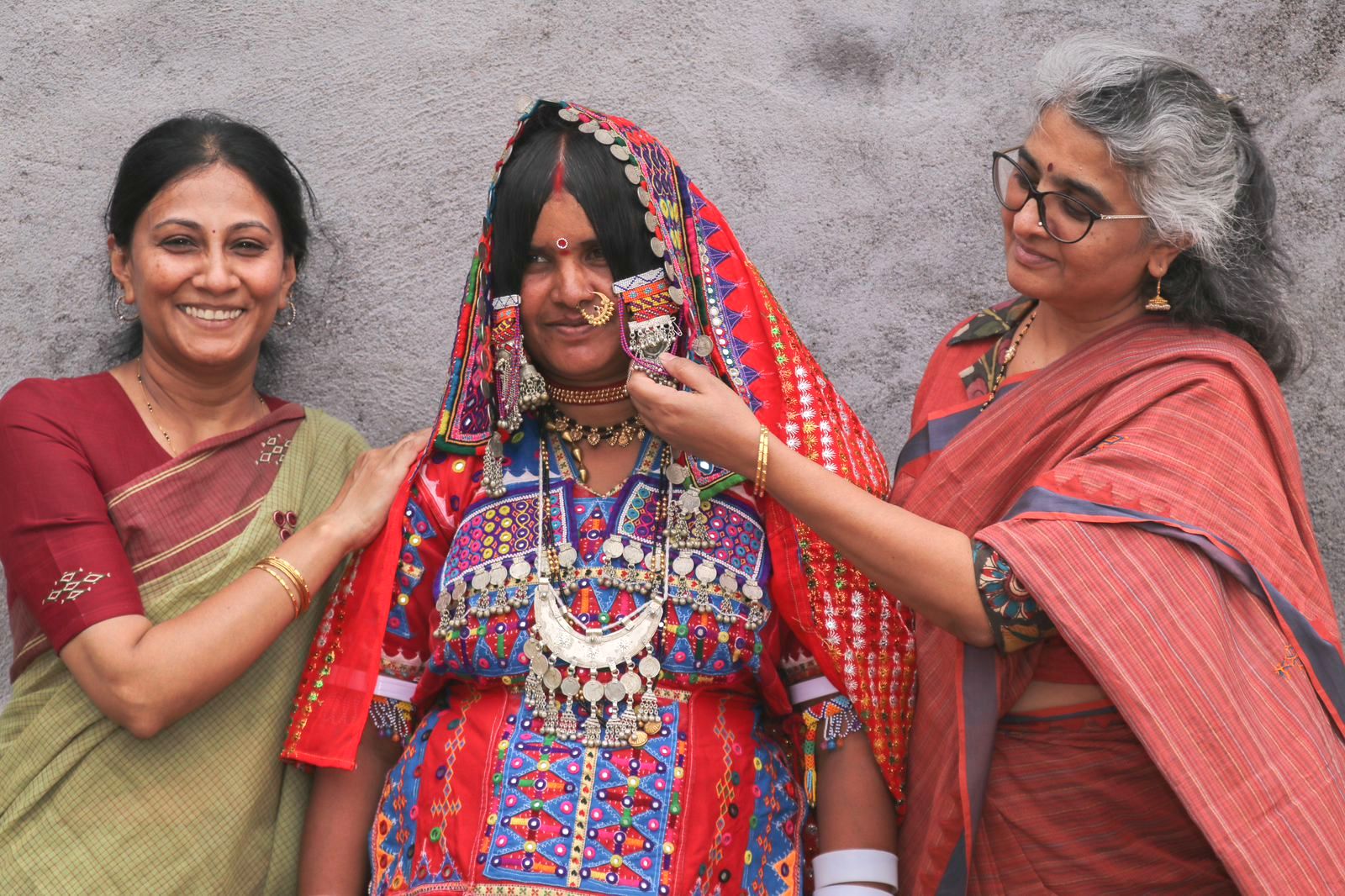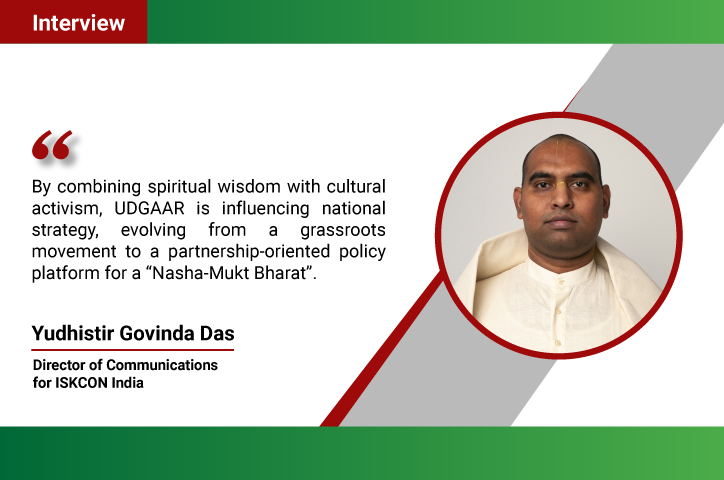 In a world where traditions are too often swept aside by the tide of modernity, Ms. Asha Patil stands as a dedicated guardian of her community’s heritage and a steadfast advocate for women’s empowerment. Co-founding Banjara Kasuti in 2017 with Ms. Seema Kishor, she embarked on a mission inspired by the vibrant Lambani embroidery of her youth, determined to preserve this unique cultural artistry that risked fading into obscurity. With each stitch and the artisans' infectious cheerfulness, Banjara Kasuti bridges generations, skillfully blending traditional designs with contemporary fashion to make ancient crafts relevant and desirable today.
In a world where traditions are too often swept aside by the tide of modernity, Ms. Asha Patil stands as a dedicated guardian of her community’s heritage and a steadfast advocate for women’s empowerment. Co-founding Banjara Kasuti in 2017 with Ms. Seema Kishor, she embarked on a mission inspired by the vibrant Lambani embroidery of her youth, determined to preserve this unique cultural artistry that risked fading into obscurity. With each stitch and the artisans' infectious cheerfulness, Banjara Kasuti bridges generations, skillfully blending traditional designs with contemporary fashion to make ancient crafts relevant and desirable today.
But Banjara Kasuti is not simply about beautiful embroidery. At its core, it is a social enterprise built to uplift and empower the Lambani women artisans of North Karnataka. Through specialized training programs, market linkages, and a focus on financial independence, Banjara Kasuti has transformed lives, offering women the opportunity to become entrepreneurs, contribute to their families, and reclaim a sense of pride and identity.
Yet, like many mission-driven initiatives, Banjara Kasuti faces significant hurdles, especially when it comes to securing CSR funding. While CSR funds could play a pivotal role in furthering Banjara Kasuti’s impact, navigating the competitive funding landscape and conveying the profound value of cultural preservation to potential sponsors remains a challenge. In this heartfelt conversation, Ms. Asha Patil sheds light on the resilience of Lambani artisans, the ongoing struggle for sustainable support, and her hopes for a future where traditional crafts thrive hand-in-hand with women’s empowerment and community development.
Read the full interview below for in-depth insights.
Q&A
Q. Can you share the inspiration behind founding Banjara Kasuti and how your personal experiences shaped your vision for the organization, particularly regarding the role of art and traditional crafts in promoting economic development and community resilience in today’s rapidly changing world?
A. The inspiration behind founding Banjara Kasuti came during a visit to Bijapur (Vijayapura), where I noticed a significant shift—fewer Lambani women were wearing their traditional attire, opting instead for more affordable alternatives. This observation sparked the realization that if action wasn’t taken, the intricate embroidery of the Lambani community might be lost over time. That was when we decided to establish Banjara Kasuti in 2017 with the vision of ensuring that this beautiful and vibrant craftsmanship never goes out of style.
At Banjara Kasuti, our focus is; preserving the ancient art of Lambani embroidery and empowering the women who are creating it. By providing them with an economic lifeline, we help these women achieve financial independence. This became especially critical during the COVID-19 pandemic when many of these women became the sole breadwinners for their families and their resilience shone through as they worked hard to support their loved ones while preserving their community’s heritage and identity.
We aim to uplift the women in the community, offering them stable income opportunities while contributing to economic development and community resilience in today’s rapidly evolving world.
Q. How do you balance the preservation of traditional Lambani embroidery techniques with the need to adapt to modern fashion trends, and what impact has this had on the artisans you work with? What challenges have you faced in this regard?
A. We balance the preservation of traditional Lambani embroidery techniques with modern fashion trends by staying true to the craft’s roots while incorporating contemporary elements. At Banjara Kasuti, we strive to maintain the authenticity of the embroidery, allowing artisans the creative freedom to infuse their personal touch into the designs. This helps ensure that the essence of the art remains intact, even as we adjust fabrics and styles to align with current fashion preferences.
We aim to reinterpret traditional motifs into modern silhouettes, creating pieces like kurtis and jackets that appeal to today’s audience. By focusing on using natural fibers and high-quality materials, we also work toward sustainability, trying to keep our environmental impact low while offering durable, long-lasting products. This helps keep the Lambani craft relevant and appealing in the modern fashion landscape.
For the artisans, this approach has opened up new opportunities to express their skills in ways that resonate with contemporary tastes. However, we’ve faced challenges along the way. The fashion industry is competitive, and it can be difficult for ancient art forms to find their place in the mainstream. Reviving Lambani embroidery is not just about preserving a centuries-old tradition but also about helping people reconnect with this rich heritage.
Moreover, expanding the market for this craft has provided much-needed livelihoods for many women, offering them stability and a path to financial independence.
Q. What specific training programs does Banjara Kasuti offer? Can you share a success story of a woman artisan who has benefited from these programs, illustrating the broader impact on her family and community?
A. We offer freedom of expression and creativity to the ladies we just support when in understand the colour scheme that is to be focused on. Lambani embroidery form is an ancient art form that is beautifully intricate in itself, Lambani ladies are highly skilled and the older ladies at Banjara Kasuti teach the younger generation so that old age art is not lost in the new age of fast fashion.
Thirty-year-old Kavitha Rathore, who became associated with Banjara Kasuti eight years ago, feels she is finally able to continue the legacy of designing her own clothes, a tradition the women in her community have followed for generations. She believes this opportunity has allowed her to keep the practice alive while also earning a steady livelihood. Rathore plans to use her earnings to fund the education of her three children while passing on their generational craft to them.
Q. In your experience, what are the most significant challenges women face in achieving financial independence in rural communities, and how does Banjara Kasuti address these challenges? Have you encountered any particular experiences with women artisans that have moved you or changed your perspective on your work and influenced your approach and strategies?
 A. In rural communities, women face significant challenges in achieving financial independence, including limited access to stable employment, inadequate skills training, and societal pressures that often confine them to traditional roles. Since our inception in 2017, Banjara Kasuti has focused on enhancing employment for Lambani women, starting with just 32 artisans. We aimed to transition these women from seasonal, part-time work to full-time employment in a supportive environment.
A. In rural communities, women face significant challenges in achieving financial independence, including limited access to stable employment, inadequate skills training, and societal pressures that often confine them to traditional roles. Since our inception in 2017, Banjara Kasuti has focused on enhancing employment for Lambani women, starting with just 32 artisans. We aimed to transition these women from seasonal, part-time work to full-time employment in a supportive environment.
Today, artisans from multiple tandas in Karnataka create beautifully embroidered garments, and we have plans to expand our workforce by the end of the year. Even during the COVID-19 pandemic, we prioritized their well-being by ensuring consistent work and fair wages. Our participation in crafts and textile exhibitions has also opened new avenues for selling their creations, fostering both economic stability and skill development within the community.
One particularly moving experience involved a woman artisan who, after joining our program, not only gained financial independence but also found her voice in the community. Hearing her speak about how her newfound skills allowed her to support her family and contribute to local decisions reshaped my perspective on our mission. It reinforced the belief that our work goes beyond just embroidery; it’s about creating pathways for women to thrive and preserve their traditional skill forms.
Q. What primary challenges does Banjara Kasuti currently face in expanding its operations and reaching a wider audience? Have collaborations with corporates, NGOs, or government agencies helped you mitigate these challenges? Please elaborate.
A. Banjara Kasuti currently faces challenges in expanding its operations, including limited access to funding, scaling production, and reaching a wider audience. While we have made strides in enhancing visibility through crafts exhibitions and online platforms, further growth requires additional resources and marketing support. Collaborations with corporates like Amazon have been instrumental in mitigating these challenges, providing us with a platform to reach to a wider audience.
Q. Given that CSR funding can be a valuable resource, what challenges does Banjara Kasuti face in securing these funds effectively? Additionally, what suggestions do you have for improving the process of obtaining and utilizing CSR funds to maximize their impact on your organization, the communities you serve, and the preservation of Banjara embroidery?
A. Banjara Kasuti does face challenges in securing CSR funding effectively, including competition for limited resources and the need to demonstrate measurable impact to potential funders. Additionally, the lack of awareness about traditional crafts like the Lambani embroidery can make it difficult to communicate our value proposition to CSR stakeholders. To improve the process of obtaining and utilizing CSR funds, we suggest enhancing our visibility by showcasing successful case studies and impact metrics that highlight the benefits of supporting our initiative. Building partnerships with established organizations can also strengthen our credibility and attract more attention from CSR programs.
Furthermore, creating tailored proposals that align with specific CSR goals—such as women's empowerment, sustainable livelihoods, and cultural preservation—can make our projects more appealing to potential funders.
Q. How do you empower artisans through market linkages, financial literacy, and fair-trade practices while fostering local community engagement and minimizing reliance on outside intermediaries? What strategies do you implement to ensure that artisans have a voice in Banjara Kasuti’s initiatives and access to sustainable markets for their crafts?
A. At Banjara Kasuti, we aim to empower artisans through several strategies that focus on market linkages, financial literacy, and fair-trade practices. We establish direct connections between artisans and markets, minimizing reliance on outside intermediaries, that allows artisans to retain a larger share of their earnings. By participating in crafts exhibitions and leveraging online platforms, we help them reach a wider audience.
Fostering local community engagement is vital; we actively involve artisans in decision-making processes related to our initiatives, ensuring their voices are heard. Regular feedback sessions allow them to share their insights and suggestions, that we incorporate into our programs. This approach not only empowers artisans but also helps build a sustainable market for their crafts, promoting both their economic independence and the preservation of traditional Banjara embroidery.
Q. What innovative approaches have you adopted to sustain artisans' livelihoods amidst market fluctuations or changing consumer preferences?
A. To sustain artisan’s livelihoods amidst market fluctuations and changing consumer preferences, we have adopted innovative approaches such as diversifying our product range to blend traditional Banjara embroidery with contemporary designs. By enhancing our online presence for direct-to-consumer sales, we reduce dependency on intermediaries and increase profit margins. We are exploring collaborations with fashion designers and a focus on sustainable practices further align our offerings with market trends. By actively involving artisans in decision-making, we foster resilience and ensure that their insights shape our strategies, ultimately providing stable livelihoods in a dynamic market.
Q. What role do you see technology playing in the future of traditional crafts like Lambani embroidery, and how is Banjara Kasuti leveraging technology to enhance its reach and impact?
A. Technology will play a key role in the future of traditional crafts like Lambani embroidery by enabling artisans to connect with wider markets and preserving cultural heritage. First, we want to utilize e-commerce platforms and social media to increase visibility and facilitate direct sales, allowing artisans to reach consumers globally. We also employ digital marketing strategies to tell our artisans' stories, highlighting their skills and the cultural significance of their crafts. By embracing technology, Banjara Kasuti aims to amplify its impact, providing artisans with sustainable livelihoods while preserving and promoting the rich heritage of Lambani embroidery.
Q. How do you raise awareness about the importance of preserving traditional arts and crafts in a rapidly changing world? What role do you believe society plays in supporting cultural heritage?
A. We raise awareness about the importance of preserving traditional arts and crafts through a multifaceted approach that includes exhibitions, and social media campaigns. By showcasing the skills and stories of Lambani artisans, we highlight the cultural significance of their crafts and engage the public in meaningful conversations about heritage.
Consumer choices can drive demand for handmade, artisanal products, creating economic opportunities for artisans. Furthermore, public support for initiatives that promote and fund traditional crafts encourages the preservation of cultural practices. Ultimately, fostering a collective sense of responsibility toward cultural heritage can help ensure that these invaluable traditions continue to thrive in a rapidly changing world.
 Q. What are your future goals for Banjara Kasuti? Are there plans to expand your initiatives to reach more artisans or other communities facing similar challenges?
Q. What are your future goals for Banjara Kasuti? Are there plans to expand your initiatives to reach more artisans or other communities facing similar challenges?
A. Looking ahead, our primary goal for Banjara Kasuti is to expand the reach and impact of traditional Lambani embroidery by increasing our artisan base, empowering more women, and promoting the Lambani craft form. We plan to strengthen our online presence by leveraging social media and e-commerce platforms, such as Amazon, to connect with a wider audience.
Additionally, we aim to collaborate with fashion designers to create exclusive collections that incorporate lambani embroidery, blending tradition with modern trends. Ultimately, our mission is to empower artisans economically while ensuring that lambani embroidery remains a vital part of our cultural heritage. We also envision expanding our initiatives to support other communities facing similar challenges, fostering resilience across the region.
Q. If you had the opportunity to create a national or international campaign to promote the importance of cultural preservation and women’s empowerment through crafts, what key message would you convey to social sector stakeholders, and why?
A. If given the opportunity to create a national or international campaign to promote cultural preservation and women’s empowerment through crafts, our key message would be to Empower Her Hands, Sustain Our Heritage. This message emphasizes the dual impact of supporting artisans, highlighting that investing in women’s skills not only uplifts communities but also safeguards cultural traditions.
Engaging social sector stakeholders is crucial, as their support can drive initiatives that foster economic independence for women while ensuring that valuable crafts are passed down through generations. Together, we can create a sustainable ecosystem where both empowerment and cultural heritage thrive.



 In a world where traditions are too often swept aside by the tide of modernity, Ms. Asha Patil stands as a dedicated guardian of her community’s heritage and a steadfast advocate for women’s empowerment. Co-founding Banjara Kasuti in 2017 with Ms. Seema Kishor, she embarked on a mission inspired by the vibrant Lambani embroidery of her youth, determined to preserve this unique cultural artistry that risked fading into obscurity. With each stitch and the artisans' infectious cheerfulness, Banjara Kasuti bridges generations, skillfully blending traditional designs with contemporary fashion to make ancient crafts relevant and desirable today.
In a world where traditions are too often swept aside by the tide of modernity, Ms. Asha Patil stands as a dedicated guardian of her community’s heritage and a steadfast advocate for women’s empowerment. Co-founding Banjara Kasuti in 2017 with Ms. Seema Kishor, she embarked on a mission inspired by the vibrant Lambani embroidery of her youth, determined to preserve this unique cultural artistry that risked fading into obscurity. With each stitch and the artisans' infectious cheerfulness, Banjara Kasuti bridges generations, skillfully blending traditional designs with contemporary fashion to make ancient crafts relevant and desirable today. A. In rural communities, women face significant challenges in achieving financial independence, including limited access to stable employment, inadequate skills training, and societal pressures that often confine them to traditional roles. Since our inception in 2017, Banjara Kasuti has focused on enhancing employment for Lambani women, starting with just 32 artisans. We aimed to transition these women from seasonal, part-time work to full-time employment in a supportive environment.
A. In rural communities, women face significant challenges in achieving financial independence, including limited access to stable employment, inadequate skills training, and societal pressures that often confine them to traditional roles. Since our inception in 2017, Banjara Kasuti has focused on enhancing employment for Lambani women, starting with just 32 artisans. We aimed to transition these women from seasonal, part-time work to full-time employment in a supportive environment.  Q. What are your future goals for Banjara Kasuti? Are there plans to expand your initiatives to reach more artisans or other communities facing similar challenges?
Q. What are your future goals for Banjara Kasuti? Are there plans to expand your initiatives to reach more artisans or other communities facing similar challenges?











.jpg)




